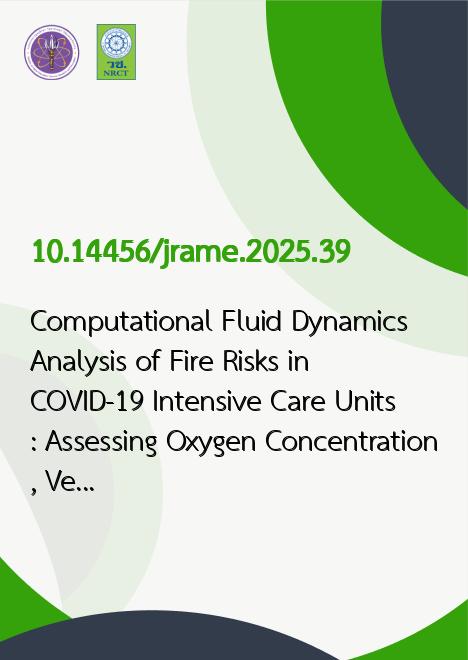
|
Computational Fluid Dynamics Analysis of Fire Risks in COVID-19 Intensive Care Units: Assessing Oxygen Concentration, Ventilation Effectiveness, and Material Flammability in High-Risk Healthcare Environments |
|---|---|
| รหัสดีโอไอ | |
| Creator | 1. PK. Pant 2. S. Kothari 3. H. Verma 4. MK. Pathak 5. Amit Joshi 6. S. Chamoli |
| Title | Computational Fluid Dynamics Analysis of Fire Risks in COVID-19 Intensive Care Units: Assessing Oxygen Concentration, Ventilation Effectiveness, and Material Flammability in High-Risk Healthcare Environments |
| Publisher | Thai Society of Mechanical Engineers (TSME) |
| Publication Year | 2568 |
| Journal Title | Journal of Research and Applications in Mechanical Engineering (JRAME) |
| Journal Vol. | 13 |
| Journal No. | 3 |
| Page no. | JRAME-25-13-039 (p.1-12) |
| Keyword | Thermal performance, zigzag-winglet, perforated-tape, Nusselt number, Reynolds number |
| URL Website | https://ph01.tci-thaijo.org/index.php/jrame/index |
| Website title | Journal of Research and Applications in Mechanical Engineering (JRAME) |
| ISSN | 2229-2152 |
| Abstract | This study examines the threats to fire safety in intensive care units (ICUs) during the COVID-19 pandemic, concentrating on ventilation effectiveness and oxygen concentration. Increased safety precautions are required in light of many deadly fires in intensive care units (ICUs), which were mostly brought on by electrical short circuits and made worse by elevated oxygen levels. Oxygen dispersion and concentration fluctuations were modeled in congested ICU rooms under various ventilation situations using Computational Fluid Dynamics (CFD) techniques. Important studies show that if ventilation systems fail, ICU rooms become high-risk zones in 6–10 minutes, with potentially catastrophic oxygen concentration levels. The study shows that natural ventilation is inadequate in critical care settings for controlling infection risks and oxygen levels. Oxygen distribution is greatly improved by increasing the number of mechanical ventilation points, which lowers fire risk. Furthermore, a number of textiles and polymers become combustible at oxygen concentrations between 24% and 35%, according to an analysis of the Limiting Oxygen Index (LOI) of popular ICU materials. In critical care settings, the study highlights the significance of appropriate ventilation design, reliable power backup systems, and cautious material selection. These results offer vital information for improving ICU fire safety procedures and safeguarding patients and medical staff in environments with high oxygen levels. |
